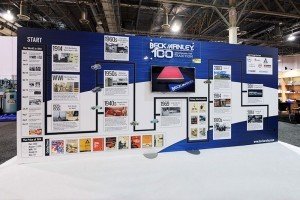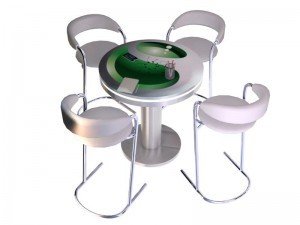What Should be in your trade show budget, but isn’t?
If you’ve done a trade show or two, you know what the basic elements of a trade show budget are. The list can include:

Custom Eco-Friendly eSmart Inline Convertible to (2) 10x10s. Features Vinyl Woven Panels, Lockable Storage, Puck Lighting, Monitor Mounts, and Modified ECO-31C Counter
- Booth Space
- Trade Show Display Booth
- Installation and Dismantle Expenses
- Drayage
- Freight
- Transportation
- Audio Visual Support
- Cleaning
- Floral
- Electrical
- Plumbing
- Internet
- Security
- Lead Gathering Services
- Hosts/Hostesses/Narrators
- Personnel Expenses
- Special Events
Here’s the tough part: each category can have its own costs and contingencies that, if overlooked, can balloon your budget and sink your previous estimates.
To get at the closest estimate of your own costs, it’s necessary to do a close, hard look at your expenses and find out where the money is slipping away.
Here are ten areas that can have the biggest impact on your trade show budget. Being prepared with the “real” costs can save your program a substantial amount of money. Whatever you do, focus on getting the most trade show bang for your buck.
1) Booth Space:
Start with the published cost per square foot.
But read the contract with a watchful eye.
You may be eligible for a discount if you’re a member of the association producing the show.
You may also be in for a hit to your budget if you have an island location.
There may also be fees for late payment.
For most of the popular shows, the sooner you sign up, the better choice of booth space.
All these things can impact your budget.
2) Transportation:
If you have a large booth space and exhibit, shipping costs can be very high. If that’s the case, ask your transportation provider for an estimate.
Then work with them to explore the most cost-effective means for your shipments to get from Point A to Point B.
Do you do enough shows that you can negotiate a special rate with a single carrier?
Keep in mind you’ll still pay for last-minute pick-ups and shipments, air freight and any split shipments that happen at the close of a show.
3) Trade Show Display Booth
New design and construction is usually a capital expense to be amortized over a certain number of shows.
You’ll still have expenditures for graphics changes, minor refurbishments and crate repairs, along with accessories like lighting and literature racks, among others.
And the budget buster here can be all the things that end up happening at the last minute: those graphics changes, for example.
The more advance warning you give your suppliers, the less likely you’ll be billed overtime – and be sure to avoid rush shipping costs, they can really eat into a budget fast!
4) Installation and Dismantle
Your first assignment is to familiarize yourself with your exhibit booth and be aware how many hours it takes to set up and dismantle under normal conditions.
But you need to accept the fact that the show floor is never a “normal” environment.
Many times, moving in or out will necessitate overtime hours.
Your exhibit company or I&D contractor may add a supervision fee if you don’t provide a staff supervisor.
Several different unions may be involved in certain circumstances, all charging varying rates.
And sometimes, innocuous details can get you in trouble with the show and the union; some city convention centers require union labor for installing lights or even plugging them in – so check in advance, to avoid being charged last minute floor prices for a task you planned to do yourself.
5) Electrical/Plumbing/Internet
In most cases, you’re stuck with the official supplier, which is good in that the people doing the work are familiar with the hall and all the various codes involved.
All the cords, lines, hoses, cables and connectors don’t appear magically.
They’re charged to your bill and they require labor to install and take out at the end of the show.
Be sure you get the lines run at the right time in your set-up process, so cables can be run unobtrusively, and won’t necessitate taking down a part of your exhibit or removing the carpet, only to put it them back up again.
You can still save a little in this category by ordering the services you require in advance.
At least you won’t be charged the floor prices, which can be astronomical.
6) Drayage
The costs in this category are based on the weight of your freight, but there may be additional charges for uncrated items.
This is another area where last minute shipments of parts, literature and product prototypes can eat into your budget dramatically.
There will usually be a separate minimum weight charge for each shipment.
Your best money-saving step is to pack everything into one shipment.
Next, be sure to check invoices carefully at the close of the show and dispute any charges while the situation is still fresh in peoples’ minds.
7) Cleaning/Floral/Security
My best advice is simply to remember to include these costs in your budget.
Also remember that cleaning is generally billed at a per-square-foot rate, per day (not per show).
Some exhibitors save money by purchasing artificial plants, which can look good and, better yet, last through several shows.
Security can end up being cheap insurance against not just losing something valuable, but losing something you couldn’t do the show without.
8) Hosts/Hostesses/Narrators
The more expertise your talent has, the more you’ll spend for their services.
One exhibitor connected with a local college and found several students who were willing to work the show, handing out literature and other simple things at minimum wage.
If you do use a professional staffing service, try to find talent that’s local to the show, so you can skip paying travel and hotel costs for these people.
But remember, your narrator is the voice of your company in front of potentially thousands of show visitors, so if you scrimp, you may end up with someone that doesn’t support your company’s image.
9) Lead Gathering Services
Many shows rent badge scanners and other lead gathering equipment.
Investigate whether buying your own will make sense in the long run.
Consider if you want to use traditional lead gathering forms, filled out by your staffers in place of, or in addition to, the badge scanner.
If you do (and this approach has its advantages), add the cost of printing to your show budget.
10) Everything Else
There are countless small expenses that, taken together, can be budget busters: from extension cords and computer cables to tape, breath mints and aspirin.
Show after show, these things add up.
Maintaining a contingency in your trade show budget to cover these minor, but frequent, expenses will help you balance things out in the long run.
Minimize your trade show budget by using exhibits that are modular & light weight. Click To TweetWhen it comes to smart trade show planning, we can help you maximize your trade show marketing impact and minimize your trade show budget:
- by using trade show exhibits that are modular (so they can be used in a variety of configurations),
- light weight (to save on shipping costs)
- and available with a wide range of accessories, from lighting to literature racks and product display kiosks.
For more ideas on how to save money, check out our article on stretching your trade show dollar.
Whatever your needs might be, we want to help. Call us at (800) 676-3976 or email [email protected].


